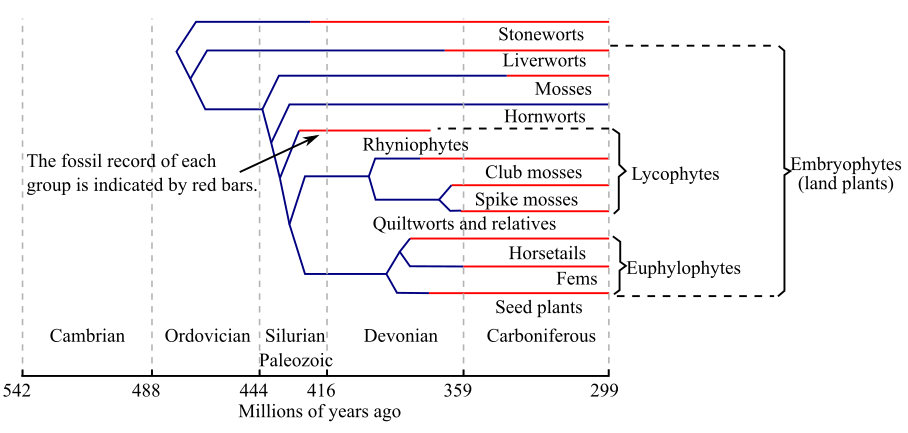
Concept explainers
To review:
The time and the geological period when the last common ancestor of the seed plants as well as ferns lived.
Given:
The fFigure 1 shows the geological timescale of the origin of various embryophytes (land plants) including ferns and seed plants.
Figure 1: The geological timescale of the origin of various embryophytes.

Introduction:
Horsetails, ferns, and seed plants form a clade commonly referred as euphyllophytes. These are the true leaf plants. Another important characteristic feature of these plants is overtopping. It is a growth pattern, where one branch of the plant gets differentiated from the other and grows beyond that other branch. This feature gives an advantage to the plants in competition for light.
Explanation of Solution
It can be clearly observed from Figure 1 that the common ancestor of ferns as well as the seed plants originated about 390 million years ago in the mid-Devonian period of the Paleozoic era. Today, the ferns comprise of more than 12,000 species whereas there are about 15 known species of horsetails. The species of horsetails lie in a single genus, Equisetum. It can be noticed that horsetail species are more closely linked to ferns as compared to the seed plants.
Therefore, it can be concluded that common ancestor of ferns and seed plants arose in mid-Devonian about 390 million years ago.
Want to see more full solutions like this?
- What would be a more distinct lifestage in seedless vascular plants? Sporophyte or Gametophytearrow_forwardWhat key traits distinguish each group from the other listed in the comparison? A) All land plants from green algae? B) Pteridophyta (ferns) from Bryophyta (mosses)? C) Angiosperms from ferns?arrow_forwardWhat are leaves? what are the two types? What is the difference between homosporous plants and heterosporous plants? What are megaspores and microspores? What was significance of the ecological role of seedless vascular plants back when they dominated terrestrial habitats? Why is that so important to our modern world today?arrow_forward
- In the vascular bundles of flowering plants, protoxylem is closest to the center of the stem, and metaxylem is father out. Is this an endarch or an exarch arrangement, but what about the early vascular plants. Were they endarch or exarch, or did both types occur originally?arrow_forwardDescribe and compare at least two differences in the stem architecture of the ferns and the ancient conifers.arrow_forwardDescribe how the leaves of ferns and seed plants likely evolvedfrom branched-stem systems.arrow_forward
- How did the evolution of lignin helped ferns successfully thrive in their new environmentarrow_forwardHow does the evolution of endodermis, lignified cell walls, sclerenchyma, vascular tissues, true roots and leaves support the survival of vascular plants on land?arrow_forwardDescribe two adaptations that are present in mosses, but not hornworts or liverworts, which reflect steps of evolution toward land plants.arrow_forward
- Know and Comprehend 12. Which of the following statements about ferns is not true? (a) ferns have motile sperm cells that swim through water to the egg-containing archegonium (b) ferns are vascular plants (c) ferns are the most economically important group of bryophytes (d) the fern sporophyte consists of a rhizome, roots, and fronds (e) the diversity of ferns is greatest in the tropicsarrow_forwardIn the vascular bundles of flowering plants, protoxylem is closest to the center of the stem, and metaxylem is farther out. Is this an endarch or an exarch arrangement? Seed plants always have just this one arrangement, but what about the early vascular plants? Were they endarch or exarch, or did both types occur originally?arrow_forwardWhat is the correct order of appearance in the fossil record, starting with the earliest: flowering plants, ferns, gymnosperms?arrow_forward
 Biology 2eBiologyISBN:9781947172517Author:Matthew Douglas, Jung Choi, Mary Ann ClarkPublisher:OpenStax
Biology 2eBiologyISBN:9781947172517Author:Matthew Douglas, Jung Choi, Mary Ann ClarkPublisher:OpenStax Biology: The Dynamic Science (MindTap Course List)BiologyISBN:9781305389892Author:Peter J. Russell, Paul E. Hertz, Beverly McMillanPublisher:Cengage Learning
Biology: The Dynamic Science (MindTap Course List)BiologyISBN:9781305389892Author:Peter J. Russell, Paul E. Hertz, Beverly McMillanPublisher:Cengage Learning Biology (MindTap Course List)BiologyISBN:9781337392938Author:Eldra Solomon, Charles Martin, Diana W. Martin, Linda R. BergPublisher:Cengage Learning
Biology (MindTap Course List)BiologyISBN:9781337392938Author:Eldra Solomon, Charles Martin, Diana W. Martin, Linda R. BergPublisher:Cengage Learning


